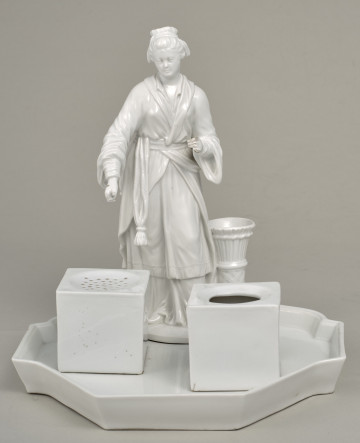
Writing set
Castle Museum in Łańcut
Part of the collection: Ceramics
A pot A decorative pot used to insert a flower pot was made in a maiolica manufactory in Nieborów. The factory called the 'Manufactory of Artistic Faience and Tile Stoves' was founded by Prince Michał Piotr Radziwiłł in 1881, on the premises of his residence. The factory director was Stanislaw Thiele, an experienced ceramic artist who had previously worked at the faience factory in Nevers, France. The manufactory in Nieborów produced a variety of decorative and utilitarian items: vases, jugs, cache-pôt pots, jardinieres, wall-hanging plates, toiletries, hanging lamps, wall tiles; it specialised in cooker tiles. The eclectic ceramics is in line with historicising trends in European ceramics of the second half of the 19th century. The forms and ornamentation were based on Italian and French maiolica and Dutch faience. The old-style forms were often combined with painting decorations on Polish themes. These were landscapes, views of famous localities, illustrations of Polish legends, images of kings and national heroes. The manufactory's prosperity period lasted until 1886; the collapse of production took place around 1889. In the collection of the Castle Museum in Łańcut, there is a set of eleven decorative maiolica, such as vases, jardiniers, cache-pôt (see B. Trojnar, Majolika w zbiorach Muzeum-Zamku w Łańcucie. Katalog Maiolica in the Collection of the Castle Museum in Łańcut. The Catalogue, Łańcut 1988). The Łańcut pot is decorated with two multicolour painted scenes illustrating Polish legends: about King Piast, Saint Kinga. Piast, a wheelwright at work, is visited by two mysterious wanderers. It is the day of his son's christening. The wanderers are hospitably received by the poor Piast, for which they are supposed to foretell a great future for his family. On the other side of the vessel, Prince Bolesław the Chaste and his wife Kinga, daughter of King Bela IV of Hungary, are shown against a landscape. It was the wedding ring of Kinga, who threw it into the Hungarian salt mines when she found out about the lack of salt in Poland. Soon rich deposits of salt were discovered near Krakow, in Wieliczka and Bochnia, among which the ring was found. Barbara Trojnar
Other names
flowerpot
Author / creator
Dimensions
height: 29 cm, width: 35 cm
Object type
Ceramics
Technique
hand painted, underglaze paints, tin glaze
Material
faience, porcelain
Origin / acquisition method
purchase
Creation time / dating
Creation / finding place
Owner
Castle Museum in Łańcut
Identification number
Location / status